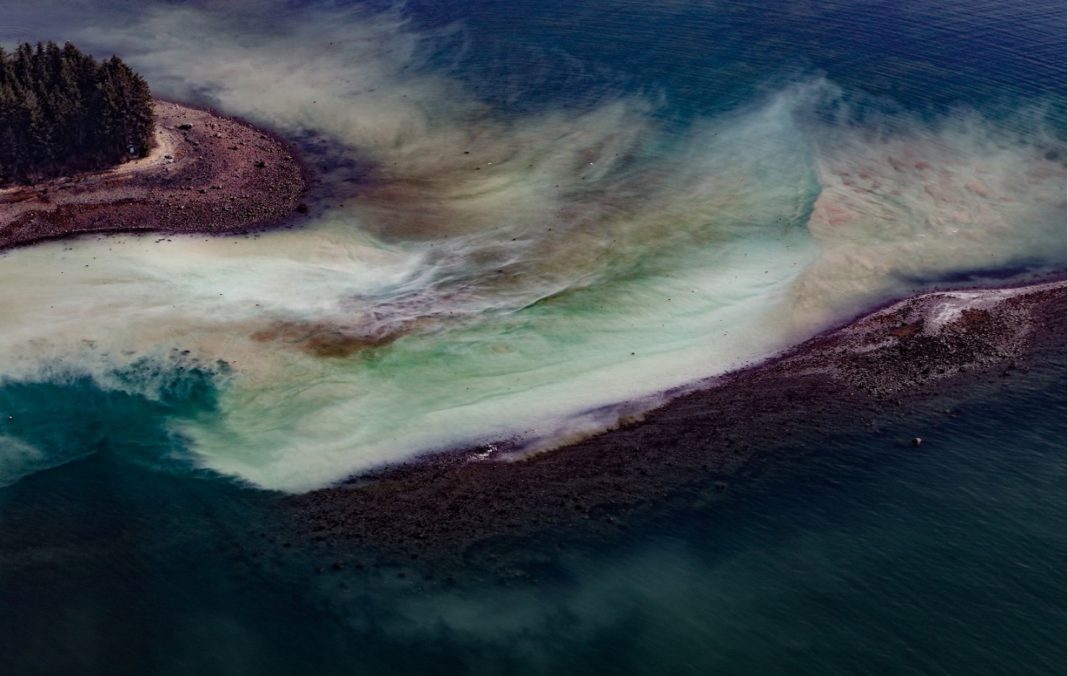W. Scott Pegau and Hayley Hoover discuss the plight of forage fish, with a particular emphasis on understanding the lack of recovery of Pacific herring in Prince William Sound, Alaska
Pacific herring (Fig. 1) are food for fish, birds, and marine mammals and are an important subsistence and commercial fisheries resource. They are among the most numerous forage fishes in Prince William Sound, Alaska, yet their population is a small fraction of what it was in the late 1980s. The biomass dropped from around a peak of over 140 metric tons to about 20 metric tons in a few years in the early 1990s (Fig. 2). The drop was most likely the result of a disease outbreak. Since then, the population has remained around 20 metric tons except for a recent decline to about five metric tons.
Figure 1. A school of Pacific herring in Prince William Sound
Pacific herring research
A team of researchers from universities, government agencies, and non-profit organizations have been trying to understand why the herring population has not recovered to its historic levels. Proposed hypotheses include whale predation, elevated disease levels, competition with hatchery-released salmon, and many others. The simplest explanation is that the recruitment of juvenile fish is not enough to overcome the mortality of adult fish. Is the problem with recruitment, mortality, or a combination of the two?
The first problem is knowing how many fish there are at both the juvenile and adult stages. Studying marine fish is difficult because the ocean is large, and the fish can be anywhere in the water column. The easiest way to monitor the spawning population is by using airplane-based surveys of fish spawning along the shoreline (Fig. 3) combined with vessel-based surveys of fish schools. In Prince William Sound, herring begin spawning when three years old. Therefore, we use other methods to determine the number of younger herring and what factors affect their survival to adults.
We use airplanes to survey juvenile herring schools and examine the diet of marine birds and whales to understand how juvenile herring populations change over time. Recruitment of juvenile herring to the adult population showed only one very large recruitment over two decades between 1992 and 2014. This is an unusually long stretch without a significant recruitment event. Other populations also had minimal recruitment, so the problem appeared widespread throughout the Gulf of Alaska. However, it had a greater impact on the Prince William Sound herring population because of the small population size.

The plight of a forage fish
After recent marine heatwaves, many herring populations from the Gulf of Alaska to the Bering Sea increased, some to record levels. The 2016-year class appears to have benefited from the 2014-2016 marine heatwave in the Gulf of Alaska. The heatwave was associated with smaller zooplankton that better matched larval herring’s gape size (mouth opening). The timing and size of the zooplankton peak also coincided with larval herring beginning to feed. The warm waters likely allowed juvenile fish to grow faster, which reduced their vulnerability to predation. Still, these conditions existed for several years, but only one year ended up with exceptional recruitment.
It has been hypothesized that occupancy in the nursery grounds may limit recruitment through competition for resources or cannibalism. If this is the case, it would help explain the four-year cycle in recruitment that has been observed at different times in the Gulf of Alaska. The fish remain in or near the nursery grounds through the first three years of life. Only when most have recruited at age four can the nursery areas accommodate another large year class.
Interestingly, a strong 2016-year class from throughout the Gulf of Alaska suggests large-scale factors drive survival in the first year of life. In contrast, the 2012 year class was weak in the Prince William Sound population while strong elsewhere, suggesting that local factors can also limit survival prior to recruitment to the spawning population. This is where mortality becomes important. Many predators eat herring, and we estimate that 25% of the adult population in Prince William Sound dies each year. Whales can eat a lot of herring in a day, but so can various fish, and there are many more fish than whales.
We also have evidence of chronic disease factors that are extremely lethal and also need to be considered in that annual mortality. These factors may also be interacting. Disease may weaken the fish, making them more vulnerable to predation. Harassment by whales may stress the fish, making them more vulnerable to disease and compacting the schools, which allows disease to spread more rapidly.
Future work on other forage fish populations
We expect that there will long be debates about the reasons for crashes in forage fish populations and what may limit their recovery. Is it the whales, competition with salmon, disease outbreaks, or other factors? Is the population being limited by the mortality of the adult population, or is something preventing recruitment? We hope the work with Pacific herring in Prince William Sound will answer some of these questions and help guide future work on other forage fish.

This work is licensed under Creative Commons Attribution-NonCommercial-NoDerivatives 4.0 International.


